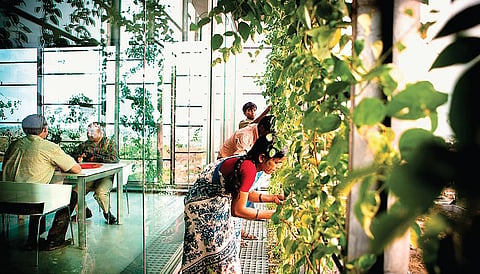

NEW DELHI: Rahul Mehrotra, sporting his signature look of round eyeglasses perched on his forehead, was the first to kickstart the speaker lineup at the just concluded India Design ID 2020, Okhla NSIC Grounds.
The Founder of RMA Architects and professor of Urban Design and Planning at the Harvard Graduate School of Design, largely illustrated how architecturally through his projects he provided solutions for climate change (or ‘crisis’ as he calls it). We caught up with Mehrotra post his talk. Excerpts:
Is Delhi an architectural challenge given its extreme weather conditions?
There are two things we’ve become averse to as we get wealthier. One, we have an anathema to maintenance. I can’t tell you how many clients tell me ‘choose whatever material you want, as long as it’s maintenance-free’.
We say don’t say that for our bodies, do we? What has happened is that conversations in products, marketing and design, have changed from weathering to weather-proofing.
We want everything to be weather-proof. While we admire the buildings in Italy because they have that patina of decay, here, we want alucobond so there’s no maintenance, and then we complain that all our buildings look synthetic.
Secondly, we want a fixed lifestyle; we want to eat jamun in both summer and winter, though it’s a summer fruit.
We forget that roti, kapda, makaan, are all climate and weather dependant.
If only we can learn to adapt, like opening our windows to let in the hot air enter during the day and closing it to let the hot air stay in.
But we don’t want that because air-conditioning keeps temperatures steady through the year.Historically, architecture’s prime response has always been to climate.
During the debates about whether form follows functions, Charles Correa wrote an important article in the 1970s where he said form follows climate, and that function will adapt.
Do you have an architectural solution to Delhi’s air pollution?
Different problems have to be addressed at different scales. Some have to be addressed on a larger scale (national, regional), some on a medium scale (city and metropolitan), and some on a small scale, which is of architecture.
Air pollution, for instance, needs a national policy, because pollution moves with the air, so the breeze will bring something in Tamil Nadu up to the middle of the country.
On the medium scale, for Delhi-NCR it means controlling the burning of crop waste in Punjab.
On a small scale, it might require pedestrianising areas of Delhi, and creating green facades for buildings. There’s no magic bullet at the level of architecture.
You’ve been known to write letters to the government with regard to your sustainable projects. Does this make you an activist?
But in a democracy, anyone who has a problem should be able to address it without being called an activist.
The deafer the people in power get, the more active you must get in shouting the problem. Perhaps, as professionals we are equipped in ways to see the problem and therefore better intervene for the solution, and therefore we feel compelled to talk about it, write about it, speak about it, and in the process become advocates.
If people call me an advocate, I cringe a little. Advocacy is just one part of my work.
Sustainable design is perceived as the costlier option.
My problem is with the word sustainable. Everything is sustainable. My dream is have a conference where I call people from schools of business, anthropology, design, planning, economics, literature, and more, and ask them each to spend 10 minutes explaining how they understand sustainability.
For the business guys, ‘sustainable business’ means you make money forever. For architects, it involves climate, air-conditioning. Sustainability is a cultural shift, where we leave a better planet for our children, sustain the resources, and think about life in ways that are less harmful.
How do you convince your clients to settle for your design solution?
If you don’t have the knowledge about a problem, then your intervention is seen as superficial. That’s why I do a lot of research, writing; this helps build your credibility.
I also try to ensure the client and I are on the same side. For me, I’m their consultant. I never say, ‘this is the model; this is the design, now we’ve got to do it’.
The moment you and the client bond on values, the aesthetics and architecture will happen automatically.
Then you don’t have to fight those battles. ‘I want all the workers to feel equal’, ‘I want to create a comfortable environment’...these are values.
Architects often enter the solution space with an aesthetic solution, and then have clients pushing back….
Does it feel like fighting a losing battle when it comes to climate?
I never feel I’m fighting a losing battle. We fight battles with the wrong things, at the wrong place and the wrong scale.
If I had looked at the Hathigaon [a housing project for mahouts and their elephants near Jaipur] as a two-year project, it would feel like a lost battle.
Instead, I thought of what I can put here to make it a better environment for the next generation.
So even if the CM rejected something or a PWD guy didn’t follow my details for the project, on the larger scale, overall those didn’t feel important.